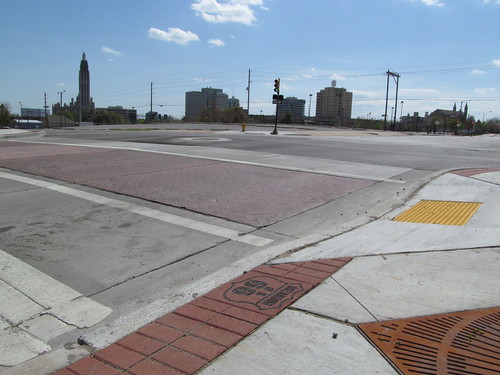Tulsa Downtown: May 2014 Archives
The East Village District Association, on the eastern edge of downtown Tulsa, is holding its second Second Saturday street festival this Saturday, May 10, 2014, from 11 am to 4 pm, at the corner of 3rd and Lansing. The event will feature local music, art, vendors, and food trucks.
The East Village is bounded by Elgin Ave. and the east leg of the Inner Dispersal Loop, between 3rd Street and 11th Street, plus the area between the Frisco tracks and 3rd Street east of Greenwood Ave. Until work on the IDL began in 1967, the area had been seamlessly connected to the Pearl District, but somewhat separated from downtown by the Midland Valley tracks.
The heart of the district is a cluster of one- and two-story buildings near the intersection of 3rd and Kenosha. Kenosha is the eastern boundary of Tulsa's original townsite, in which the streets were laid out parallel and perpendicular to the Frisco railroad tracks. East of Kenosha is the Hodge Addition, aligned with the compass. The terminating vistas created by this collision of conflicting grids inspired then-resident Dave Berray to propose the name Hodge's Bend for the neighborhood association he helped to organize. If I recall correctly, Berray was anxious to distinguish the cluster of older buildings that were already being reused and already becoming a neighborhood from whatever massive redevelopment might take place on the former industrial lands to the south.
The potential of the East Village for urban revival was recognized as early as December of 1990, when Spaghetti Warehouse announced plans to locate in the old Crane Warehouse at 623 E. 3rd Street, about a year after the chain had opened in Oklahoma City's Bricktown. The following August, the building was gutted by arson, just as renovations were set to begin, and that December, Spaghetti Warehouse bought a building in the Brady Village area, triggering renewed interest in the warehouse district north of the Frisco tracks, but leaving the East Village to its own devices.
The East Village's comeback gained momentum in the late '90s, as artists (specifically theatrical scenery artists) discovered this area within the IDL that had been overlooked by urban renewal and was too far from the downtown office cluster to be worth clearing for parking. City leaders planned to demolish the neighborhood to make way for a soccer stadium, but the defeat of the Tulsa Project city sales tax in 1997 saved the East Village from oblivion. Living Arts moved to a temporary location on Kenosha in 2000 and stayed there for nine years.
Since that time, buildings have been renovated for residential, commercial, and office use, mainly along 3rd, Kenosha, and Lansing. There have been several proposals for major development in the large tracts of land between 4th and 7th streets, former sites of Nordam, Bill White Chevrolet, Fire Station No.1, and the Tulsa Coliseum, but none have come to fruition. As always, the momentum for redevelopment has been in reusing old buildings that are still standing; new construction is still somewhere off in the future.
In 2011, All Souls Unitarian Church, the largest U-U congregation in the US, announced plans to locate on the former site of the Page-Glencliff Dairy and later Fields Downs Randolph, between 6th and 7th, Frankfort and Kenosha.
The East Village District Association plans to hold a street festival the second Saturday of every month.
MORE:
I wrote about 3rd and Kenosha in Urban Tulsa in October in 2005, and again here on BatesLine in 2006, about the 1997 letter from Allison Geary that alerted me to the neighborhood's plight.
Mike Easterling wrote a cover story about the East Village in the March 25, 2009, issue of Urban Tulsa Weekly.
Tulsa's Young Professionals are holding a mile-long street festival tomorrow, Sunday, May 4, 2014, from 11 a.m. to 4 p.m., in the southern part of downtown Tulsa. The event, Street CReD 2014: Urban Core, will thread its way through Tulsa's championship parking crater with "music, art, food trucks, vendors, family-friendly activities, disc golf, skate park, walking and bicycling."
Street CReD: Urban Core will celebrate what makes downtown exceptional: Its ability to bring people together and into a unique, walkable urban environment with shops, restaurants, recreation and good company.This event will bring walkability and bikeability to one of the few areas of downtown yet to see significant redevelopment activity - an area characterized by the towering spires of the Cathedral District, the optimism of Route 66 and, unfortunately, vast expanses of surface parking that add nothing to the quality and character of our downtown.
What would happen if we made southern downtown a hub of foot and bike activity? Come see us May 4 and find out.
Street CReD: Urban Core is an Open Streets event, modeled after the international Open Streets Project, which seeks to close streets temporarily so people can use them for walking, bicycling, dancing, playing and socializing. With numerous city blocks to be temporarily closed to vehicle traffic, we are opening southern downtown's streets just for you.
The route begins at 5th and Boston, turns west at 10th Street to Boulder, then south on Boulder to Veterans Park and 21st Street, then west to River Parks. North of 15th Street, the route will be closed to vehicular traffic, but open to bikes and pedestrians. Parking will be available on TCC's lots south and east of their Metro Campus buildings.
